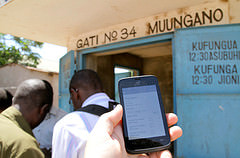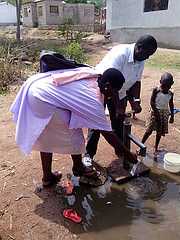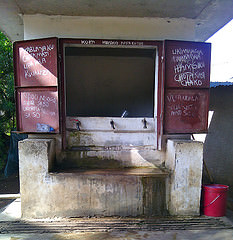Ebola 2014 — The current Ebola epidemic in West Africa which was first noted in the spring of this year began quietly but has now escalated to include five countries (Guinea, Liberia, Nigeria, Senegal, Sierra Leone) and an estimated 3707 suspected/confirmed cases with 1848 deaths (US Centers for Disease Control and Prevention Ebola Page, August 31st, 2014). The WHO declared this Ebola Virus Disease (EVD) epidemic a Public Health Emergency of International Concern on August 8, 2014 (WHO on Ebola Virus Disease). Despite this declaration, the new Ebola cases continue. Recently the Rt value for this epidemic was reported to be greater than 1 and less than 2 (R>1 and R<2) (Nishiura H. and Chowell G. Eurosurveillance 2014). These numbers soberly reminds us that the number of Ebola cases are not slowing down but are in fact growing which, appeals for immediate and urgent action to reduce and cease Ebola transmission. This plea has been echoed by prominent virologist and infectious disease experts, Richard E. Besse, Michael T Osterholm and “Science Magazine.”
To aid in this global problem, Annie Feighery, an expert in using technology to improve public health, describes lessons she has learned from her work in West Africa with mWater, a mobile water sanitation tracking system, and how these lessons can be applied to the current Ebola situation.
Alyson
—–
Lessons for Ebola, from 3 years of water source mapping & monitoring in the African continent
by Annie Feighery
The West Africa Ebola outbreak has been said to be the World’s Katrina. This means we are witnessing one of our lifetimes’ worst tragedies which is largely due to the significant gaps in the local health infrastructure. Many of the stressors in what is now the worst Ebola outbreak on record are not directly Ebola-related, but rather legacy problems from generations of broken health systems. For years, the water and sanitation field has worked under very similar conditions in West Africa and learned valuable lessons about frontline health monitoring which we believe can be applied to the Ebola Response. Here we recount lessons learned on Report Systems, Checklists and Public Engagement from our work through mWater in West Africa that may be fundamental to Ebola reporting and management.
In 2011, I co-founded the organization mWater to develop technology to help communities and individuals have access to safe water by harnessing the power of smartphone technology. Our first partners were UN Habitat, the City of Mwanza, Tanzania, and the local water utility in Mwanza. It wasn’t as simple as mapping, though. By creating a unique ID number for water sources, we were able to attach information to a source that could be updated over time. In the case of water, we mapped whether the source was functioning and we used a cheap but highly effective field test to update whether it was contaminated with E. coli, an indicator bacteria for more dangerous contaminants.
Since then, we’ve expanded our application to map sanitation facilities, schools, health clinics, communities, and households. Each is a different type of site that can have a broad range of data associated with it, and that data can be updated over time with mWater surveys. The result is an infrastructure that allows data-driven policies and improved municipal management. Most important, thanks to continued investment in mWater from USAID, Water.org, WaterAid, and The Water Trust, we can now offer this service to any community or organization for free, via the mWater app and online portal. What started in Mwanza has grown to more than 2000 free and independent users in 54 countries and 7 countries where large organizations contract our services for specific projects. Our user base includes communities, governments, utilities, scientists, and organizations who build infrastructure by mapping and monitoring sites, conducting M&E surveys, and deploying health worker checklists on mobile phones and tablets.
We have learned critical lessons about how the approach of monitoring water sources over time can also be helpful in addressing major public health issues. Currently, the biggest health emergency on our planet is the West African Ebola outbreak. Our technology can help. Our team is working around the clock to leverage our software for emergency response, mapping, and monitoring of this Ebola outbreak. But our biggest contribution may be our lessons learned about digital epidemiology.
Listed below are three lessons on Report Systems, Checklists, and Public Engagement which we think encompass the critical knowledge gained over our past three years that could increase the situational awareness and health capacity for the Ebola health crisis.
Report symptoms Frontline community health workers are the best way to gather information in developing countries. For Ebola-stricken countries, the military is also being deployed as frontline health workers, conducting temperature checks and enforcing quarantines. We found that data from health workers is more accurate when health workers are asked to report symptoms rather than conduct the diagnosis themselves. A diagnosis needs local context. For example, we asked 35 health care providers throughout Mwanza to define the symptoms of diarrhea. We received a range of 18 answers including red eyes, weakness, and fever. The WHO definition of three or more loose stools in a day was only the fourth most frequent response. This is likely because many individuals in this region go their whole lifetimes without a solid stool. A loose stool in this context is not a relevant symptom. However, a case that the health worker finds significant enough to report with a list of symptoms the health worker can tick off in checked boxes makes the data actionable, regardless of the accuracy of the diagnosis.
We are using this lesson for Ebola with our own launched platform for symptom reporting. Within five seconds, frontline health workers can press their finger on a map to indicate location, automatically filing a report to the cloud-based management dashboard. The app works on and offline, which is important in low-resource regions that can have sparse connectivity. If they have time, users can provide more detailed information on symptoms with tick-checked boxes. Previous digital epidemiology attempts have attempted to focus on reports from doctors and other official sources, limiting information to a slow but steady stream from experts. The lesson with crowd-sourced data is that the validity of the data increases with the “n”, the number of reports, as opposed to traditional studies that increase validity with source quality. We are doing everything we can to increase reports, including eliminating barriers such as literacy and time expectations. We are focusing on the point of data being at the biggest interface with the community, the frontline.
Follow checklists Frontline health workers have a lot of information to remember, from diverse fields such as public health, sanitation, and community development. One very simple innovation that has been shown to dramatically reduce complications in hospitals is the use of checklists. We work to apply this same concept to community health workers, who provide the frontline health information interface for communities in developing countries. Mobile technology can help ensure that best practices make it all the way through the last mile and into the frontlines.
We can already use our Surveyor platform to deliver a checklist to smartphones, allowing us to add questions or steps that are automatically pushed to health workers and monitor whether they are using the tools provided. Real time data gathered in a cloud-based database can use checklist results from one survey to trigger another enumerator’s questions. Symptoms queried can be adapted in real time, based on growing situational awareness. All data in checklists can be quickly monitored as indicators in the Portal, a management website that deploys surveys, collects their responses in real time, and allows users to download their data as CSV forms.
Listen to the public. In a large survey of the population in Mwanza, we found that water scarcity was a bigger concern for them than water contamination. As a public health scientist, I know this is due to a survivor’s bias, where only people who survived the age of five and have the gut flora needed to survive high levels of fecal contamination are around to tell their neighbors, their family, or me about what they are worried about. I know epidemiologically that waterborne disease is the second biggest cause of infant mortality on the globe and an indicator for the other big threats to child well-being, namely lung infection and malnutrition. But I have learned that also meeting the self-assessed needs of a community is a critical must to any policy.
In water, focusing on self-assessed needs allowed the city to make a policy decision based on digital epidemiology with local buy-in. We mated the need of water scarcity with the health policy need of protecting water supply by providing more and safer water sources. Our data motivated the city to stop supporting any further construction of shallow wells, which were found to be frequently contaminated, instead approving boreholes and piped kiosks and taps for their own expansion and NGO donations.
Translating this lesson to Ebola, the communities affected are rarely hit with Ebola itself, but instead are regularly hit with diarrhea and lung infection and they have a chronic shortage of medical staff to treat those illnesses. The targeted response to Ebola while these more common life-threatening conditions go under-treated has caused distrust between communities and the emergency agencies. Taking the self-assessed need as a critical priority would mean we should also provide resources for lung infection, diarrhea, and other local health priorities alongside our effort to provide resources and expertise for Ebola.
—



